MMH352 - IHRM: Cultural Differences & HRM Strategies in Japan
VerifiedAdded on 2023/06/12
|17
|4354
|170
Report
AI Summary
This report provides a comparative analysis of cultural dimensions between Australia and Japan, based on Hofstede's model, and examines the challenges faced by multinational corporations like National Australia Bank (NAB) in managing human resources across these different cultural contexts. The study highlights the key differences in power distance, individualism, masculinity, uncertainty avoidance, long-term orientation, and indulgence between the two countries. It further elaborates on how these cultural differences impact HRM strategies, particularly in areas such as decision-making, gender equality in the workplace, and long-term versus short-term orientation. The report concludes by emphasizing the need for multinational companies to adapt their HRM policies to align with the specific cultural nuances of each country to ensure effective management and employee satisfaction. Desklib offers a range of resources, including similar reports and solved assignments, to aid students in their studies.
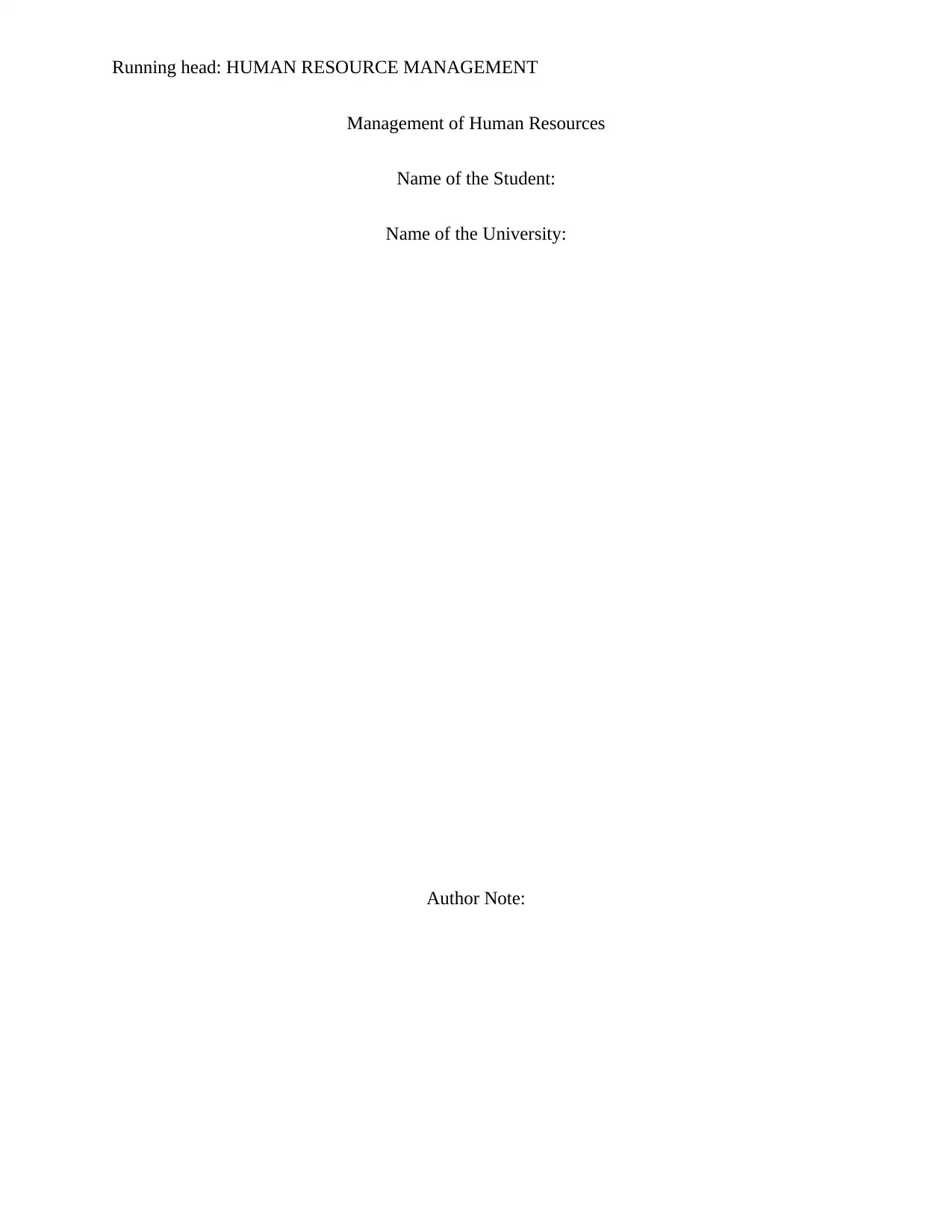
Running head: HUMAN RESOURCE MANAGEMENT
Management of Human Resources
Name of the Student:
Name of the University:
Author Note:
Management of Human Resources
Name of the Student:
Name of the University:
Author Note:
Paraphrase This Document
Need a fresh take? Get an instant paraphrase of this document with our AI Paraphraser

1HUMAN RESOURCE MANAGEMENT
Table of Contents
Introduction......................................................................................................................................2
Cultural differences between Australia and Japan...........................................................................3
Australia.......................................................................................................................................3
Japan............................................................................................................................................5
Challenges faced by the National Australia Bank with respect to the cultural differences.............7
International human resource management.....................................................................................8
Global citizenship..........................................................................................................................10
Human resource strategies.............................................................................................................11
Standardization of the HRM policies............................................................................................12
Conclusion.....................................................................................................................................13
Reference.......................................................................................................................................14
Table of Contents
Introduction......................................................................................................................................2
Cultural differences between Australia and Japan...........................................................................3
Australia.......................................................................................................................................3
Japan............................................................................................................................................5
Challenges faced by the National Australia Bank with respect to the cultural differences.............7
International human resource management.....................................................................................8
Global citizenship..........................................................................................................................10
Human resource strategies.............................................................................................................11
Standardization of the HRM policies............................................................................................12
Conclusion.....................................................................................................................................13
Reference.......................................................................................................................................14
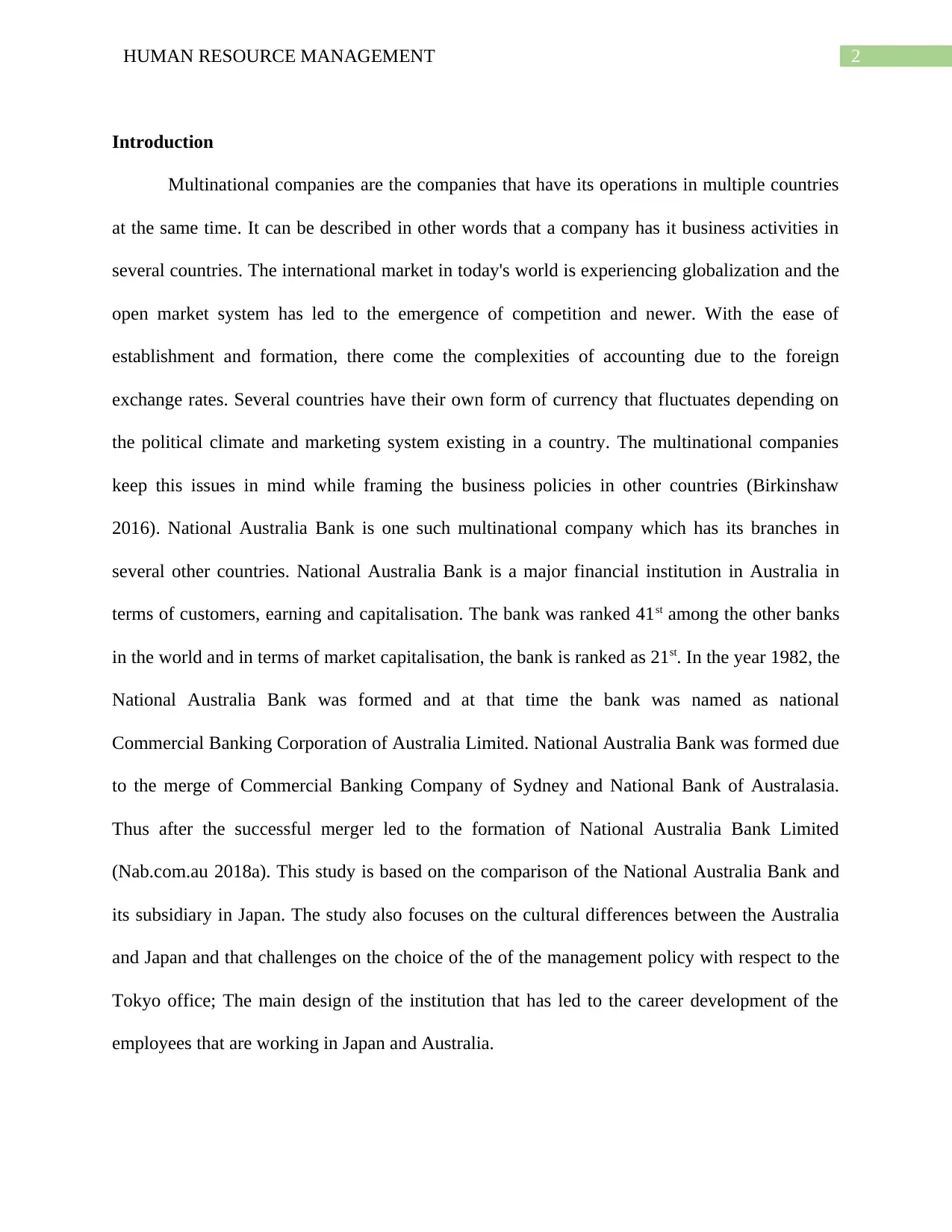
2HUMAN RESOURCE MANAGEMENT
Introduction
Multinational companies are the companies that have its operations in multiple countries
at the same time. It can be described in other words that a company has it business activities in
several countries. The international market in today's world is experiencing globalization and the
open market system has led to the emergence of competition and newer. With the ease of
establishment and formation, there come the complexities of accounting due to the foreign
exchange rates. Several countries have their own form of currency that fluctuates depending on
the political climate and marketing system existing in a country. The multinational companies
keep this issues in mind while framing the business policies in other countries (Birkinshaw
2016). National Australia Bank is one such multinational company which has its branches in
several other countries. National Australia Bank is a major financial institution in Australia in
terms of customers, earning and capitalisation. The bank was ranked 41st among the other banks
in the world and in terms of market capitalisation, the bank is ranked as 21st. In the year 1982, the
National Australia Bank was formed and at that time the bank was named as national
Commercial Banking Corporation of Australia Limited. National Australia Bank was formed due
to the merge of Commercial Banking Company of Sydney and National Bank of Australasia.
Thus after the successful merger led to the formation of National Australia Bank Limited
(Nab.com.au 2018a). This study is based on the comparison of the National Australia Bank and
its subsidiary in Japan. The study also focuses on the cultural differences between the Australia
and Japan and that challenges on the choice of the of the management policy with respect to the
Tokyo office; The main design of the institution that has led to the career development of the
employees that are working in Japan and Australia.
Introduction
Multinational companies are the companies that have its operations in multiple countries
at the same time. It can be described in other words that a company has it business activities in
several countries. The international market in today's world is experiencing globalization and the
open market system has led to the emergence of competition and newer. With the ease of
establishment and formation, there come the complexities of accounting due to the foreign
exchange rates. Several countries have their own form of currency that fluctuates depending on
the political climate and marketing system existing in a country. The multinational companies
keep this issues in mind while framing the business policies in other countries (Birkinshaw
2016). National Australia Bank is one such multinational company which has its branches in
several other countries. National Australia Bank is a major financial institution in Australia in
terms of customers, earning and capitalisation. The bank was ranked 41st among the other banks
in the world and in terms of market capitalisation, the bank is ranked as 21st. In the year 1982, the
National Australia Bank was formed and at that time the bank was named as national
Commercial Banking Corporation of Australia Limited. National Australia Bank was formed due
to the merge of Commercial Banking Company of Sydney and National Bank of Australasia.
Thus after the successful merger led to the formation of National Australia Bank Limited
(Nab.com.au 2018a). This study is based on the comparison of the National Australia Bank and
its subsidiary in Japan. The study also focuses on the cultural differences between the Australia
and Japan and that challenges on the choice of the of the management policy with respect to the
Tokyo office; The main design of the institution that has led to the career development of the
employees that are working in Japan and Australia.
⊘ This is a preview!⊘
Do you want full access?
Subscribe today to unlock all pages.

Trusted by 1+ million students worldwide
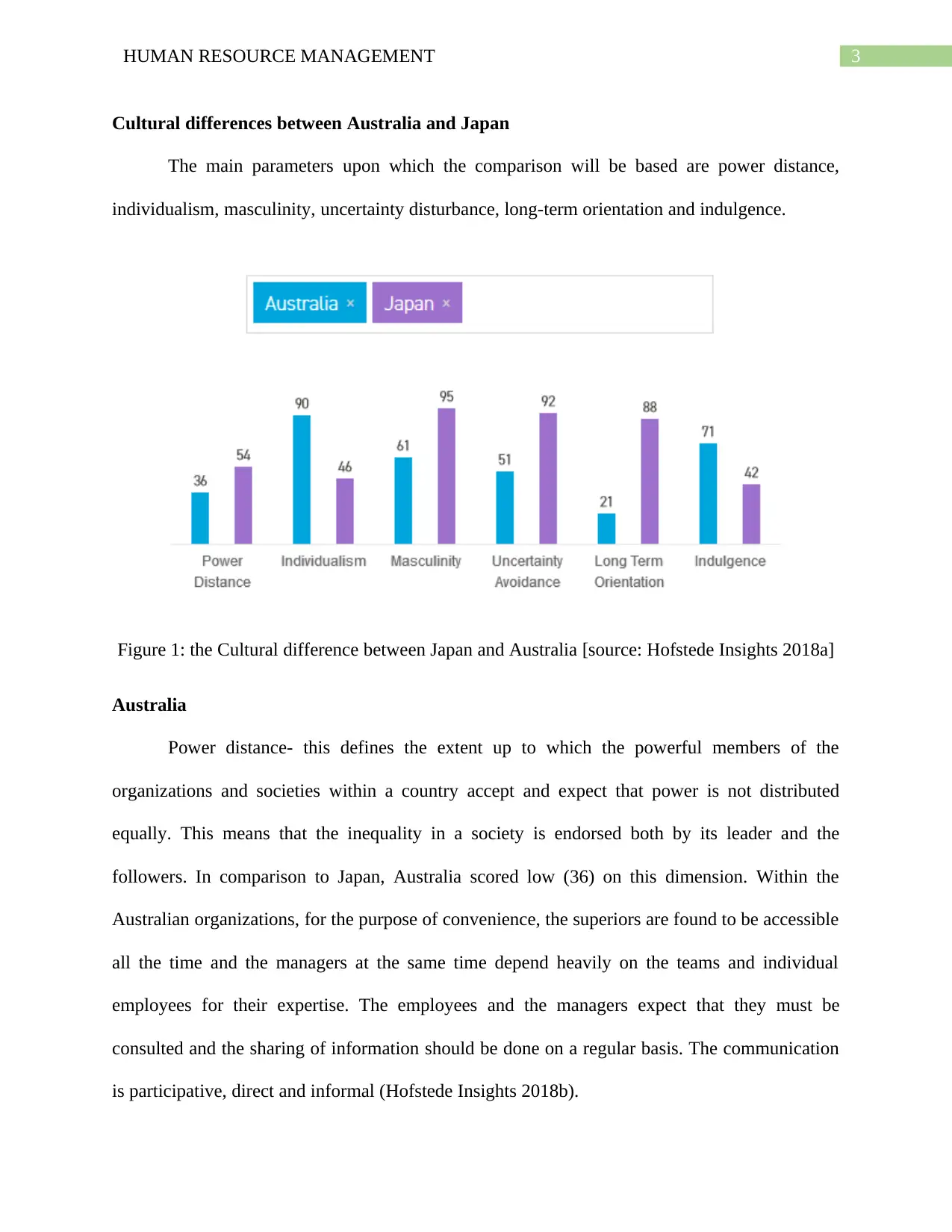
3HUMAN RESOURCE MANAGEMENT
Cultural differences between Australia and Japan
The main parameters upon which the comparison will be based are power distance,
individualism, masculinity, uncertainty disturbance, long-term orientation and indulgence.
Figure 1: the Cultural difference between Japan and Australia [source: Hofstede Insights 2018a]
Australia
Power distance- this defines the extent up to which the powerful members of the
organizations and societies within a country accept and expect that power is not distributed
equally. This means that the inequality in a society is endorsed both by its leader and the
followers. In comparison to Japan, Australia scored low (36) on this dimension. Within the
Australian organizations, for the purpose of convenience, the superiors are found to be accessible
all the time and the managers at the same time depend heavily on the teams and individual
employees for their expertise. The employees and the managers expect that they must be
consulted and the sharing of information should be done on a regular basis. The communication
is participative, direct and informal (Hofstede Insights 2018b).
Cultural differences between Australia and Japan
The main parameters upon which the comparison will be based are power distance,
individualism, masculinity, uncertainty disturbance, long-term orientation and indulgence.
Figure 1: the Cultural difference between Japan and Australia [source: Hofstede Insights 2018a]
Australia
Power distance- this defines the extent up to which the powerful members of the
organizations and societies within a country accept and expect that power is not distributed
equally. This means that the inequality in a society is endorsed both by its leader and the
followers. In comparison to Japan, Australia scored low (36) on this dimension. Within the
Australian organizations, for the purpose of convenience, the superiors are found to be accessible
all the time and the managers at the same time depend heavily on the teams and individual
employees for their expertise. The employees and the managers expect that they must be
consulted and the sharing of information should be done on a regular basis. The communication
is participative, direct and informal (Hofstede Insights 2018b).
Paraphrase This Document
Need a fresh take? Get an instant paraphrase of this document with our AI Paraphraser
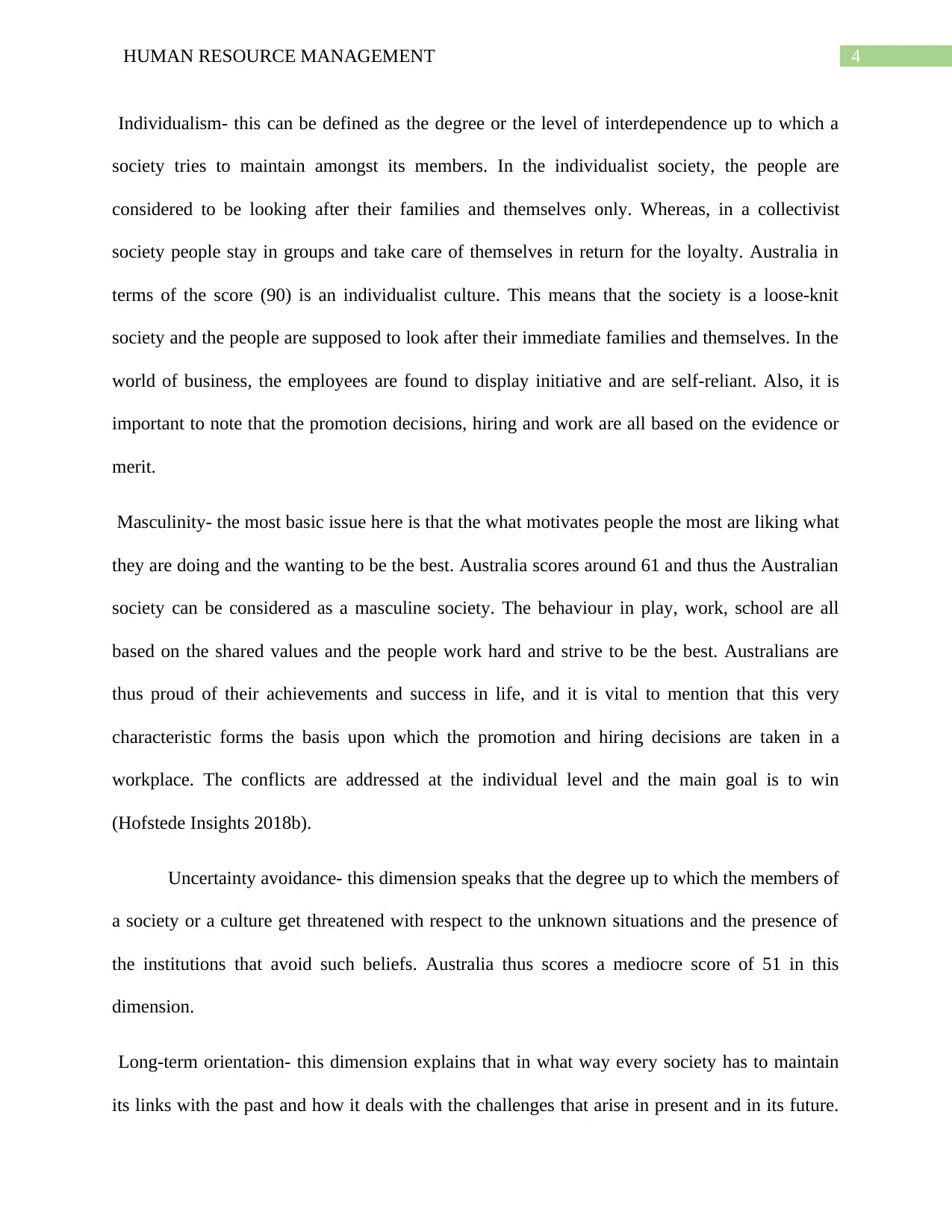
4HUMAN RESOURCE MANAGEMENT
Individualism- this can be defined as the degree or the level of interdependence up to which a
society tries to maintain amongst its members. In the individualist society, the people are
considered to be looking after their families and themselves only. Whereas, in a collectivist
society people stay in groups and take care of themselves in return for the loyalty. Australia in
terms of the score (90) is an individualist culture. This means that the society is a loose-knit
society and the people are supposed to look after their immediate families and themselves. In the
world of business, the employees are found to display initiative and are self-reliant. Also, it is
important to note that the promotion decisions, hiring and work are all based on the evidence or
merit.
Masculinity- the most basic issue here is that the what motivates people the most are liking what
they are doing and the wanting to be the best. Australia scores around 61 and thus the Australian
society can be considered as a masculine society. The behaviour in play, work, school are all
based on the shared values and the people work hard and strive to be the best. Australians are
thus proud of their achievements and success in life, and it is vital to mention that this very
characteristic forms the basis upon which the promotion and hiring decisions are taken in a
workplace. The conflicts are addressed at the individual level and the main goal is to win
(Hofstede Insights 2018b).
Uncertainty avoidance- this dimension speaks that the degree up to which the members of
a society or a culture get threatened with respect to the unknown situations and the presence of
the institutions that avoid such beliefs. Australia thus scores a mediocre score of 51 in this
dimension.
Long-term orientation- this dimension explains that in what way every society has to maintain
its links with the past and how it deals with the challenges that arise in present and in its future.
Individualism- this can be defined as the degree or the level of interdependence up to which a
society tries to maintain amongst its members. In the individualist society, the people are
considered to be looking after their families and themselves only. Whereas, in a collectivist
society people stay in groups and take care of themselves in return for the loyalty. Australia in
terms of the score (90) is an individualist culture. This means that the society is a loose-knit
society and the people are supposed to look after their immediate families and themselves. In the
world of business, the employees are found to display initiative and are self-reliant. Also, it is
important to note that the promotion decisions, hiring and work are all based on the evidence or
merit.
Masculinity- the most basic issue here is that the what motivates people the most are liking what
they are doing and the wanting to be the best. Australia scores around 61 and thus the Australian
society can be considered as a masculine society. The behaviour in play, work, school are all
based on the shared values and the people work hard and strive to be the best. Australians are
thus proud of their achievements and success in life, and it is vital to mention that this very
characteristic forms the basis upon which the promotion and hiring decisions are taken in a
workplace. The conflicts are addressed at the individual level and the main goal is to win
(Hofstede Insights 2018b).
Uncertainty avoidance- this dimension speaks that the degree up to which the members of
a society or a culture get threatened with respect to the unknown situations and the presence of
the institutions that avoid such beliefs. Australia thus scores a mediocre score of 51 in this
dimension.
Long-term orientation- this dimension explains that in what way every society has to maintain
its links with the past and how it deals with the challenges that arise in present and in its future.
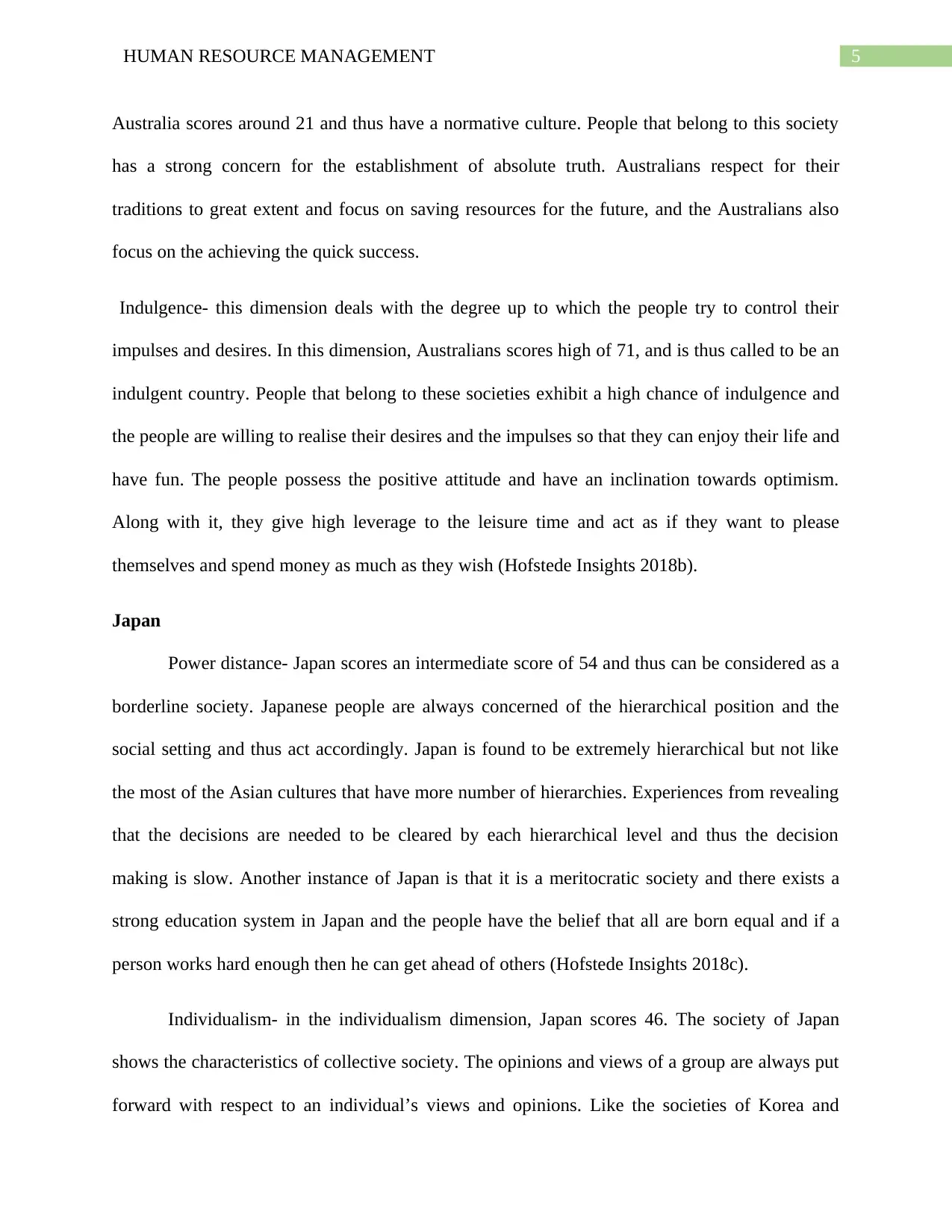
5HUMAN RESOURCE MANAGEMENT
Australia scores around 21 and thus have a normative culture. People that belong to this society
has a strong concern for the establishment of absolute truth. Australians respect for their
traditions to great extent and focus on saving resources for the future, and the Australians also
focus on the achieving the quick success.
Indulgence- this dimension deals with the degree up to which the people try to control their
impulses and desires. In this dimension, Australians scores high of 71, and is thus called to be an
indulgent country. People that belong to these societies exhibit a high chance of indulgence and
the people are willing to realise their desires and the impulses so that they can enjoy their life and
have fun. The people possess the positive attitude and have an inclination towards optimism.
Along with it, they give high leverage to the leisure time and act as if they want to please
themselves and spend money as much as they wish (Hofstede Insights 2018b).
Japan
Power distance- Japan scores an intermediate score of 54 and thus can be considered as a
borderline society. Japanese people are always concerned of the hierarchical position and the
social setting and thus act accordingly. Japan is found to be extremely hierarchical but not like
the most of the Asian cultures that have more number of hierarchies. Experiences from revealing
that the decisions are needed to be cleared by each hierarchical level and thus the decision
making is slow. Another instance of Japan is that it is a meritocratic society and there exists a
strong education system in Japan and the people have the belief that all are born equal and if a
person works hard enough then he can get ahead of others (Hofstede Insights 2018c).
Individualism- in the individualism dimension, Japan scores 46. The society of Japan
shows the characteristics of collective society. The opinions and views of a group are always put
forward with respect to an individual’s views and opinions. Like the societies of Korea and
Australia scores around 21 and thus have a normative culture. People that belong to this society
has a strong concern for the establishment of absolute truth. Australians respect for their
traditions to great extent and focus on saving resources for the future, and the Australians also
focus on the achieving the quick success.
Indulgence- this dimension deals with the degree up to which the people try to control their
impulses and desires. In this dimension, Australians scores high of 71, and is thus called to be an
indulgent country. People that belong to these societies exhibit a high chance of indulgence and
the people are willing to realise their desires and the impulses so that they can enjoy their life and
have fun. The people possess the positive attitude and have an inclination towards optimism.
Along with it, they give high leverage to the leisure time and act as if they want to please
themselves and spend money as much as they wish (Hofstede Insights 2018b).
Japan
Power distance- Japan scores an intermediate score of 54 and thus can be considered as a
borderline society. Japanese people are always concerned of the hierarchical position and the
social setting and thus act accordingly. Japan is found to be extremely hierarchical but not like
the most of the Asian cultures that have more number of hierarchies. Experiences from revealing
that the decisions are needed to be cleared by each hierarchical level and thus the decision
making is slow. Another instance of Japan is that it is a meritocratic society and there exists a
strong education system in Japan and the people have the belief that all are born equal and if a
person works hard enough then he can get ahead of others (Hofstede Insights 2018c).
Individualism- in the individualism dimension, Japan scores 46. The society of Japan
shows the characteristics of collective society. The opinions and views of a group are always put
forward with respect to an individual’s views and opinions. Like the societies of Korea and
⊘ This is a preview!⊘
Do you want full access?
Subscribe today to unlock all pages.

Trusted by 1+ million students worldwide

6HUMAN RESOURCE MANAGEMENT
China, that are more collective Japan does not have an extended society. It is important to note
that the Japanese are considered by the westerns standards as collectivists and by the Asian
standards as individualists. The Japanese are more reserved and private in comparison to the
Asians.
Masculinity- In this dimension, Japan scores 95 and is considered to be one of the masculine
societies in the world. It is, however, important to note that the generally it is considered that the
competitive and assertive behaviour that is associated with masculine culture is not evident in
Japan. It is seen clearly that the Japanese have the competing tendency between the groups. The
Japanese children from a very young age learn to compete. With respect to corporate Japan, the
employees feel motivated when they are placed on a winning team and pitted against their
competitors. Masculinity is Japanese employees are seen for the purpose of perfection and
excellence in the field of presentation, material services and material production in every aspect
of life. The tendencies of workaholism are also seen a trait of masculinity, and it is still seen that
it is difficult for the women to climb up the corporate ladders and also maintain the norm of long
and hard long hours.
Uncertainty avoidance- in this dimension, Japan scored around 92 and is the most capable
country that can avoid uncertainty on earth. This can be concluded from the fact that Japan is
constantly threatened by the tsunamis, earthquakes, volcano eruptions and typhoons. Due to the
constant threat from the natural disasters, the Japanese have learnt to prepare themselves for the
uncertain situation. In corporate Japan, the majority of effort and time is put within the study of
the feasibility and risk factors are worked out before the start of the project. The managers prefer
to consult the employees before making any vital decision. The need for the uncertainty of the
avoidance has led to the changes that are hard to realize in Japan (Hofstede Insights 2018c).
China, that are more collective Japan does not have an extended society. It is important to note
that the Japanese are considered by the westerns standards as collectivists and by the Asian
standards as individualists. The Japanese are more reserved and private in comparison to the
Asians.
Masculinity- In this dimension, Japan scores 95 and is considered to be one of the masculine
societies in the world. It is, however, important to note that the generally it is considered that the
competitive and assertive behaviour that is associated with masculine culture is not evident in
Japan. It is seen clearly that the Japanese have the competing tendency between the groups. The
Japanese children from a very young age learn to compete. With respect to corporate Japan, the
employees feel motivated when they are placed on a winning team and pitted against their
competitors. Masculinity is Japanese employees are seen for the purpose of perfection and
excellence in the field of presentation, material services and material production in every aspect
of life. The tendencies of workaholism are also seen a trait of masculinity, and it is still seen that
it is difficult for the women to climb up the corporate ladders and also maintain the norm of long
and hard long hours.
Uncertainty avoidance- in this dimension, Japan scored around 92 and is the most capable
country that can avoid uncertainty on earth. This can be concluded from the fact that Japan is
constantly threatened by the tsunamis, earthquakes, volcano eruptions and typhoons. Due to the
constant threat from the natural disasters, the Japanese have learnt to prepare themselves for the
uncertain situation. In corporate Japan, the majority of effort and time is put within the study of
the feasibility and risk factors are worked out before the start of the project. The managers prefer
to consult the employees before making any vital decision. The need for the uncertainty of the
avoidance has led to the changes that are hard to realize in Japan (Hofstede Insights 2018c).
Paraphrase This Document
Need a fresh take? Get an instant paraphrase of this document with our AI Paraphraser
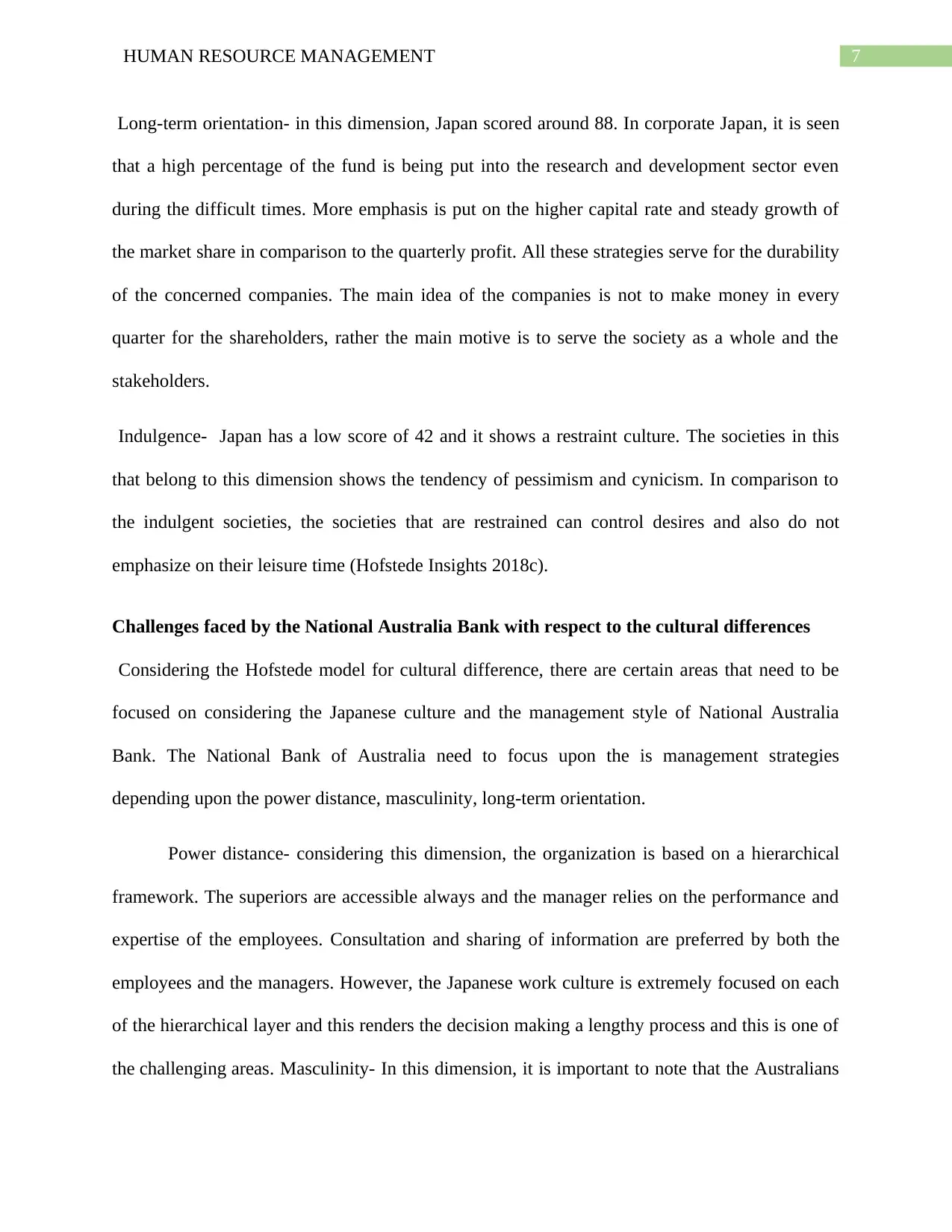
7HUMAN RESOURCE MANAGEMENT
Long-term orientation- in this dimension, Japan scored around 88. In corporate Japan, it is seen
that a high percentage of the fund is being put into the research and development sector even
during the difficult times. More emphasis is put on the higher capital rate and steady growth of
the market share in comparison to the quarterly profit. All these strategies serve for the durability
of the concerned companies. The main idea of the companies is not to make money in every
quarter for the shareholders, rather the main motive is to serve the society as a whole and the
stakeholders.
Indulgence- Japan has a low score of 42 and it shows a restraint culture. The societies in this
that belong to this dimension shows the tendency of pessimism and cynicism. In comparison to
the indulgent societies, the societies that are restrained can control desires and also do not
emphasize on their leisure time (Hofstede Insights 2018c).
Challenges faced by the National Australia Bank with respect to the cultural differences
Considering the Hofstede model for cultural difference, there are certain areas that need to be
focused on considering the Japanese culture and the management style of National Australia
Bank. The National Bank of Australia need to focus upon the is management strategies
depending upon the power distance, masculinity, long-term orientation.
Power distance- considering this dimension, the organization is based on a hierarchical
framework. The superiors are accessible always and the manager relies on the performance and
expertise of the employees. Consultation and sharing of information are preferred by both the
employees and the managers. However, the Japanese work culture is extremely focused on each
of the hierarchical layer and this renders the decision making a lengthy process and this is one of
the challenging areas. Masculinity- In this dimension, it is important to note that the Australians
Long-term orientation- in this dimension, Japan scored around 88. In corporate Japan, it is seen
that a high percentage of the fund is being put into the research and development sector even
during the difficult times. More emphasis is put on the higher capital rate and steady growth of
the market share in comparison to the quarterly profit. All these strategies serve for the durability
of the concerned companies. The main idea of the companies is not to make money in every
quarter for the shareholders, rather the main motive is to serve the society as a whole and the
stakeholders.
Indulgence- Japan has a low score of 42 and it shows a restraint culture. The societies in this
that belong to this dimension shows the tendency of pessimism and cynicism. In comparison to
the indulgent societies, the societies that are restrained can control desires and also do not
emphasize on their leisure time (Hofstede Insights 2018c).
Challenges faced by the National Australia Bank with respect to the cultural differences
Considering the Hofstede model for cultural difference, there are certain areas that need to be
focused on considering the Japanese culture and the management style of National Australia
Bank. The National Bank of Australia need to focus upon the is management strategies
depending upon the power distance, masculinity, long-term orientation.
Power distance- considering this dimension, the organization is based on a hierarchical
framework. The superiors are accessible always and the manager relies on the performance and
expertise of the employees. Consultation and sharing of information are preferred by both the
employees and the managers. However, the Japanese work culture is extremely focused on each
of the hierarchical layer and this renders the decision making a lengthy process and this is one of
the challenging areas. Masculinity- In this dimension, it is important to note that the Australians
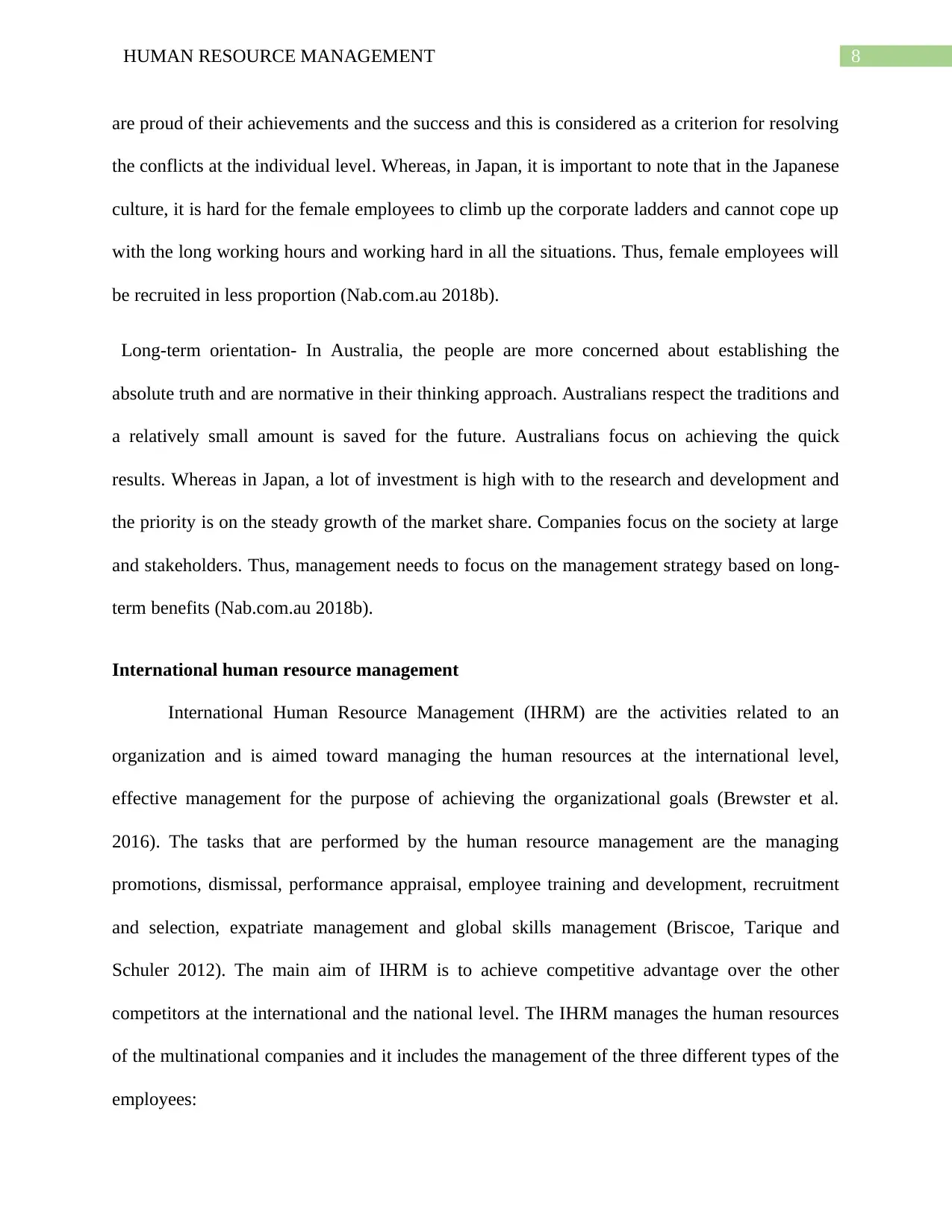
8HUMAN RESOURCE MANAGEMENT
are proud of their achievements and the success and this is considered as a criterion for resolving
the conflicts at the individual level. Whereas, in Japan, it is important to note that in the Japanese
culture, it is hard for the female employees to climb up the corporate ladders and cannot cope up
with the long working hours and working hard in all the situations. Thus, female employees will
be recruited in less proportion (Nab.com.au 2018b).
Long-term orientation- In Australia, the people are more concerned about establishing the
absolute truth and are normative in their thinking approach. Australians respect the traditions and
a relatively small amount is saved for the future. Australians focus on achieving the quick
results. Whereas in Japan, a lot of investment is high with to the research and development and
the priority is on the steady growth of the market share. Companies focus on the society at large
and stakeholders. Thus, management needs to focus on the management strategy based on long-
term benefits (Nab.com.au 2018b).
International human resource management
International Human Resource Management (IHRM) are the activities related to an
organization and is aimed toward managing the human resources at the international level,
effective management for the purpose of achieving the organizational goals (Brewster et al.
2016). The tasks that are performed by the human resource management are the managing
promotions, dismissal, performance appraisal, employee training and development, recruitment
and selection, expatriate management and global skills management (Briscoe, Tarique and
Schuler 2012). The main aim of IHRM is to achieve competitive advantage over the other
competitors at the international and the national level. The IHRM manages the human resources
of the multinational companies and it includes the management of the three different types of the
employees:
are proud of their achievements and the success and this is considered as a criterion for resolving
the conflicts at the individual level. Whereas, in Japan, it is important to note that in the Japanese
culture, it is hard for the female employees to climb up the corporate ladders and cannot cope up
with the long working hours and working hard in all the situations. Thus, female employees will
be recruited in less proportion (Nab.com.au 2018b).
Long-term orientation- In Australia, the people are more concerned about establishing the
absolute truth and are normative in their thinking approach. Australians respect the traditions and
a relatively small amount is saved for the future. Australians focus on achieving the quick
results. Whereas in Japan, a lot of investment is high with to the research and development and
the priority is on the steady growth of the market share. Companies focus on the society at large
and stakeholders. Thus, management needs to focus on the management strategy based on long-
term benefits (Nab.com.au 2018b).
International human resource management
International Human Resource Management (IHRM) are the activities related to an
organization and is aimed toward managing the human resources at the international level,
effective management for the purpose of achieving the organizational goals (Brewster et al.
2016). The tasks that are performed by the human resource management are the managing
promotions, dismissal, performance appraisal, employee training and development, recruitment
and selection, expatriate management and global skills management (Briscoe, Tarique and
Schuler 2012). The main aim of IHRM is to achieve competitive advantage over the other
competitors at the international and the national level. The IHRM manages the human resources
of the multinational companies and it includes the management of the three different types of the
employees:
⊘ This is a preview!⊘
Do you want full access?
Subscribe today to unlock all pages.

Trusted by 1+ million students worldwide
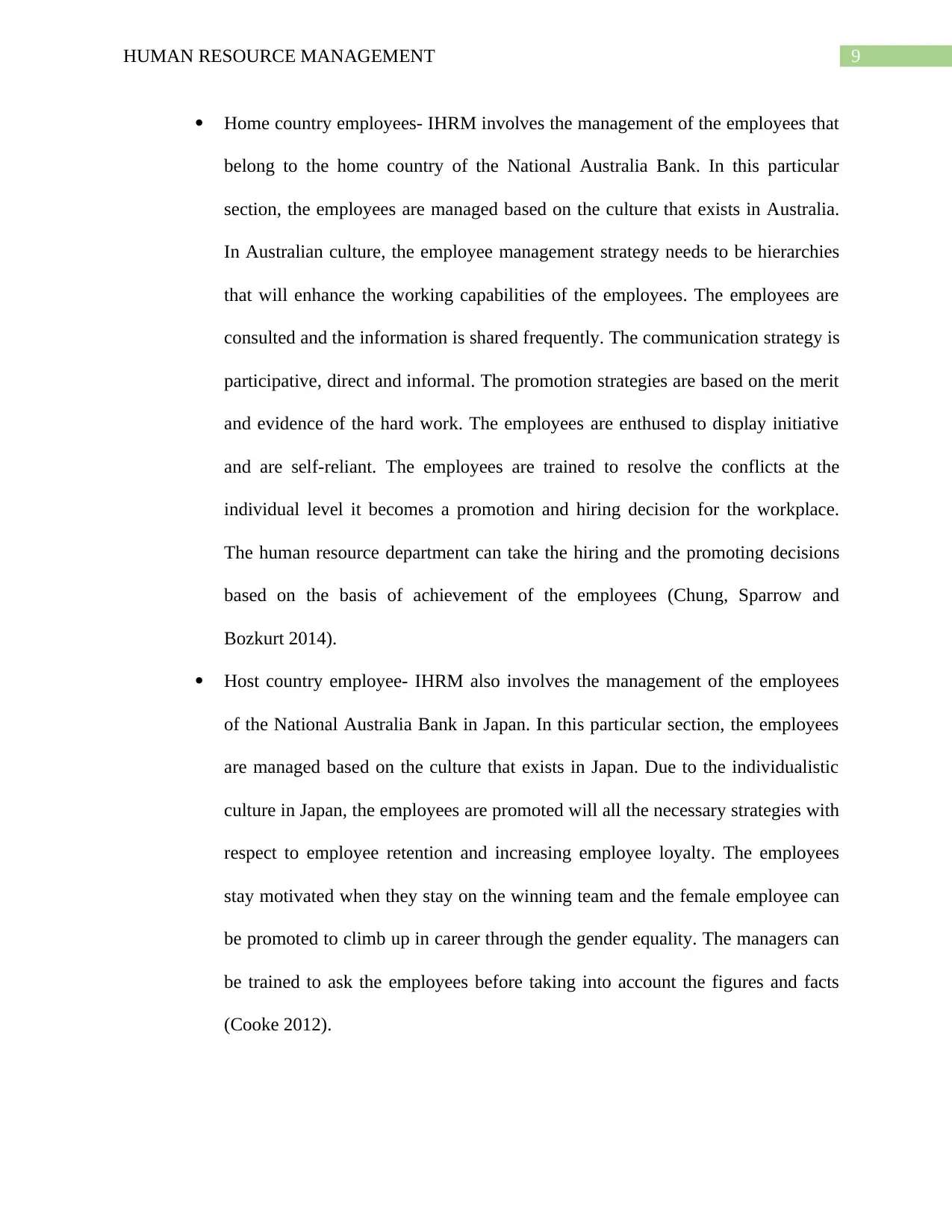
9HUMAN RESOURCE MANAGEMENT
Home country employees- IHRM involves the management of the employees that
belong to the home country of the National Australia Bank. In this particular
section, the employees are managed based on the culture that exists in Australia.
In Australian culture, the employee management strategy needs to be hierarchies
that will enhance the working capabilities of the employees. The employees are
consulted and the information is shared frequently. The communication strategy is
participative, direct and informal. The promotion strategies are based on the merit
and evidence of the hard work. The employees are enthused to display initiative
and are self-reliant. The employees are trained to resolve the conflicts at the
individual level it becomes a promotion and hiring decision for the workplace.
The human resource department can take the hiring and the promoting decisions
based on the basis of achievement of the employees (Chung, Sparrow and
Bozkurt 2014).
Host country employee- IHRM also involves the management of the employees
of the National Australia Bank in Japan. In this particular section, the employees
are managed based on the culture that exists in Japan. Due to the individualistic
culture in Japan, the employees are promoted will all the necessary strategies with
respect to employee retention and increasing employee loyalty. The employees
stay motivated when they stay on the winning team and the female employee can
be promoted to climb up in career through the gender equality. The managers can
be trained to ask the employees before taking into account the figures and facts
(Cooke 2012).
Home country employees- IHRM involves the management of the employees that
belong to the home country of the National Australia Bank. In this particular
section, the employees are managed based on the culture that exists in Australia.
In Australian culture, the employee management strategy needs to be hierarchies
that will enhance the working capabilities of the employees. The employees are
consulted and the information is shared frequently. The communication strategy is
participative, direct and informal. The promotion strategies are based on the merit
and evidence of the hard work. The employees are enthused to display initiative
and are self-reliant. The employees are trained to resolve the conflicts at the
individual level it becomes a promotion and hiring decision for the workplace.
The human resource department can take the hiring and the promoting decisions
based on the basis of achievement of the employees (Chung, Sparrow and
Bozkurt 2014).
Host country employee- IHRM also involves the management of the employees
of the National Australia Bank in Japan. In this particular section, the employees
are managed based on the culture that exists in Japan. Due to the individualistic
culture in Japan, the employees are promoted will all the necessary strategies with
respect to employee retention and increasing employee loyalty. The employees
stay motivated when they stay on the winning team and the female employee can
be promoted to climb up in career through the gender equality. The managers can
be trained to ask the employees before taking into account the figures and facts
(Cooke 2012).
Paraphrase This Document
Need a fresh take? Get an instant paraphrase of this document with our AI Paraphraser
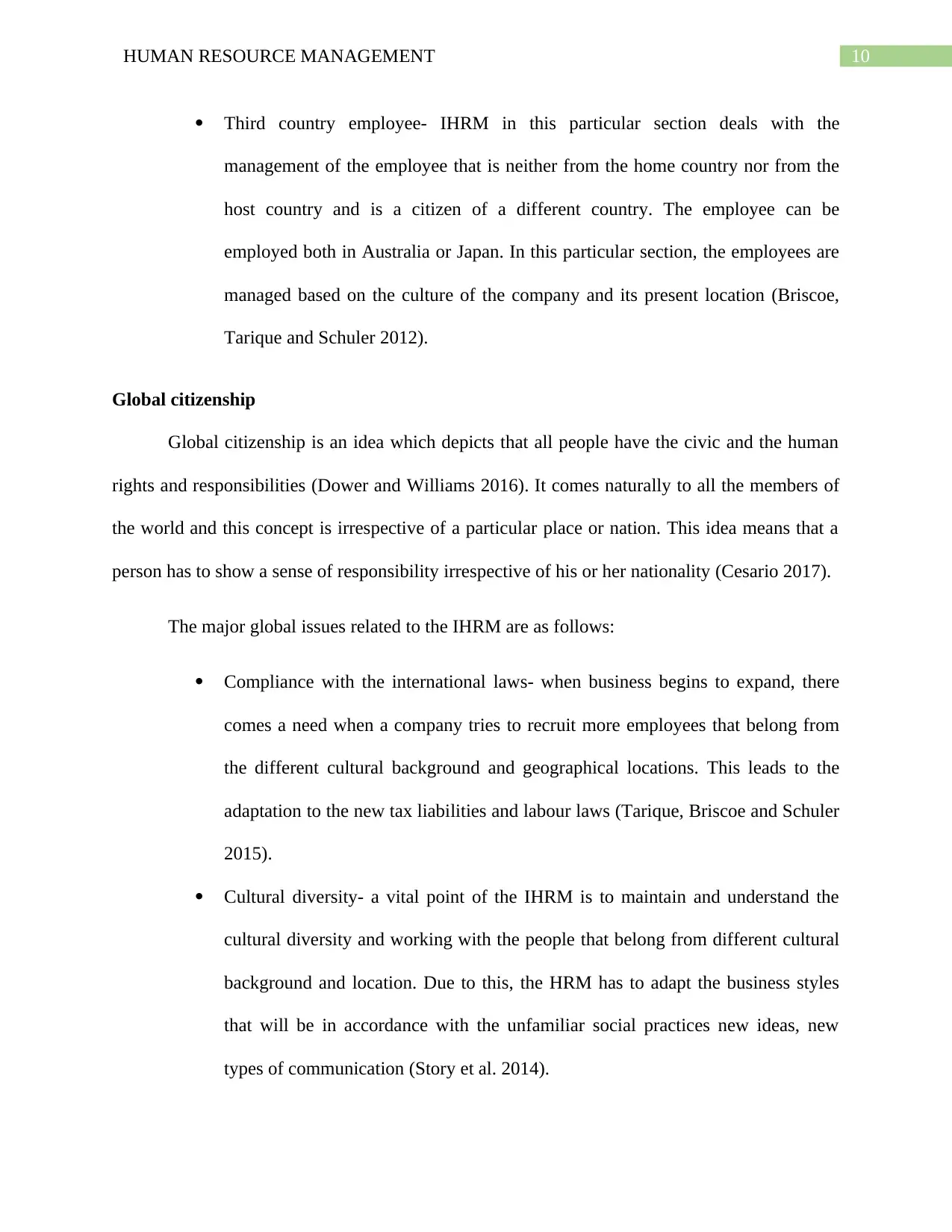
10HUMAN RESOURCE MANAGEMENT
Third country employee- IHRM in this particular section deals with the
management of the employee that is neither from the home country nor from the
host country and is a citizen of a different country. The employee can be
employed both in Australia or Japan. In this particular section, the employees are
managed based on the culture of the company and its present location (Briscoe,
Tarique and Schuler 2012).
Global citizenship
Global citizenship is an idea which depicts that all people have the civic and the human
rights and responsibilities (Dower and Williams 2016). It comes naturally to all the members of
the world and this concept is irrespective of a particular place or nation. This idea means that a
person has to show a sense of responsibility irrespective of his or her nationality (Cesario 2017).
The major global issues related to the IHRM are as follows:
Compliance with the international laws- when business begins to expand, there
comes a need when a company tries to recruit more employees that belong from
the different cultural background and geographical locations. This leads to the
adaptation to the new tax liabilities and labour laws (Tarique, Briscoe and Schuler
2015).
Cultural diversity- a vital point of the IHRM is to maintain and understand the
cultural diversity and working with the people that belong from different cultural
background and location. Due to this, the HRM has to adapt the business styles
that will be in accordance with the unfamiliar social practices new ideas, new
types of communication (Story et al. 2014).
Third country employee- IHRM in this particular section deals with the
management of the employee that is neither from the home country nor from the
host country and is a citizen of a different country. The employee can be
employed both in Australia or Japan. In this particular section, the employees are
managed based on the culture of the company and its present location (Briscoe,
Tarique and Schuler 2012).
Global citizenship
Global citizenship is an idea which depicts that all people have the civic and the human
rights and responsibilities (Dower and Williams 2016). It comes naturally to all the members of
the world and this concept is irrespective of a particular place or nation. This idea means that a
person has to show a sense of responsibility irrespective of his or her nationality (Cesario 2017).
The major global issues related to the IHRM are as follows:
Compliance with the international laws- when business begins to expand, there
comes a need when a company tries to recruit more employees that belong from
the different cultural background and geographical locations. This leads to the
adaptation to the new tax liabilities and labour laws (Tarique, Briscoe and Schuler
2015).
Cultural diversity- a vital point of the IHRM is to maintain and understand the
cultural diversity and working with the people that belong from different cultural
background and location. Due to this, the HRM has to adapt the business styles
that will be in accordance with the unfamiliar social practices new ideas, new
types of communication (Story et al. 2014).
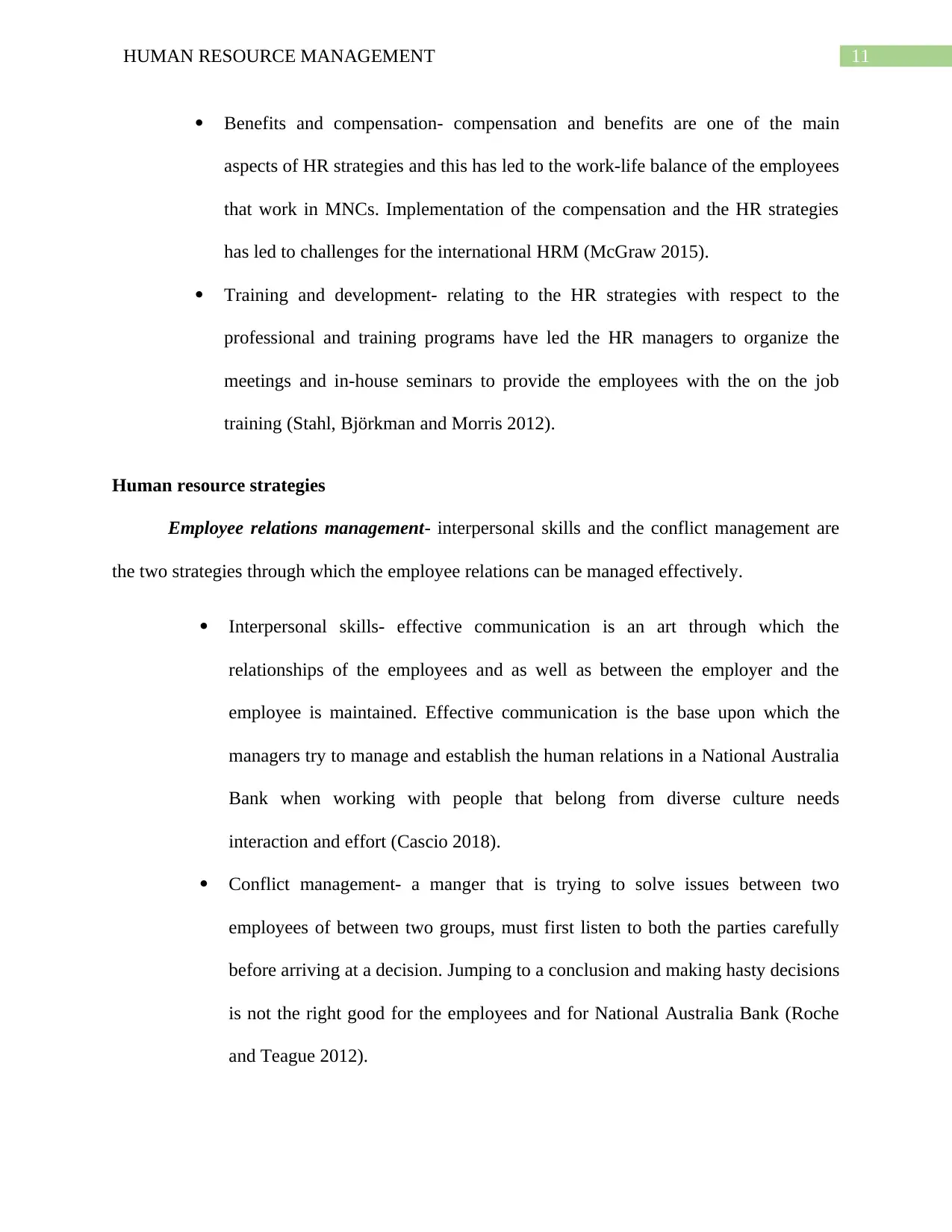
11HUMAN RESOURCE MANAGEMENT
Benefits and compensation- compensation and benefits are one of the main
aspects of HR strategies and this has led to the work-life balance of the employees
that work in MNCs. Implementation of the compensation and the HR strategies
has led to challenges for the international HRM (McGraw 2015).
Training and development- relating to the HR strategies with respect to the
professional and training programs have led the HR managers to organize the
meetings and in-house seminars to provide the employees with the on the job
training (Stahl, Björkman and Morris 2012).
Human resource strategies
Employee relations management- interpersonal skills and the conflict management are
the two strategies through which the employee relations can be managed effectively.
Interpersonal skills- effective communication is an art through which the
relationships of the employees and as well as between the employer and the
employee is maintained. Effective communication is the base upon which the
managers try to manage and establish the human relations in a National Australia
Bank when working with people that belong from diverse culture needs
interaction and effort (Cascio 2018).
Conflict management- a manger that is trying to solve issues between two
employees of between two groups, must first listen to both the parties carefully
before arriving at a decision. Jumping to a conclusion and making hasty decisions
is not the right good for the employees and for National Australia Bank (Roche
and Teague 2012).
Benefits and compensation- compensation and benefits are one of the main
aspects of HR strategies and this has led to the work-life balance of the employees
that work in MNCs. Implementation of the compensation and the HR strategies
has led to challenges for the international HRM (McGraw 2015).
Training and development- relating to the HR strategies with respect to the
professional and training programs have led the HR managers to organize the
meetings and in-house seminars to provide the employees with the on the job
training (Stahl, Björkman and Morris 2012).
Human resource strategies
Employee relations management- interpersonal skills and the conflict management are
the two strategies through which the employee relations can be managed effectively.
Interpersonal skills- effective communication is an art through which the
relationships of the employees and as well as between the employer and the
employee is maintained. Effective communication is the base upon which the
managers try to manage and establish the human relations in a National Australia
Bank when working with people that belong from diverse culture needs
interaction and effort (Cascio 2018).
Conflict management- a manger that is trying to solve issues between two
employees of between two groups, must first listen to both the parties carefully
before arriving at a decision. Jumping to a conclusion and making hasty decisions
is not the right good for the employees and for National Australia Bank (Roche
and Teague 2012).
⊘ This is a preview!⊘
Do you want full access?
Subscribe today to unlock all pages.

Trusted by 1+ million students worldwide
1 out of 17
Related Documents
Your All-in-One AI-Powered Toolkit for Academic Success.
+13062052269
info@desklib.com
Available 24*7 on WhatsApp / Email
![[object Object]](/_next/static/media/star-bottom.7253800d.svg)
Unlock your academic potential
Copyright © 2020–2026 A2Z Services. All Rights Reserved. Developed and managed by ZUCOL.





